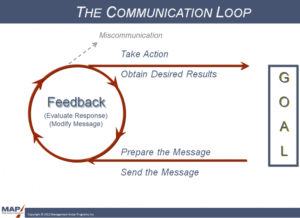Do You Have These Communication Fundamentals in Place?
We all know communication is vital to a productive, positive work culture. When communication works, people better connect, share information, and trust one another. Environments of trust sustain morale, are highly motivating, and help drive performance.
Do you have communication fundamentals in place? Below we’ve listed some best practices for productive, positive communication cultures—a few Dos and Don’ts for leaders, their teams and the organization at large. If followed, can deliver breakthrough results.
DO: Actively listen to feedback. When people give you feedback, don’t shoot the messenger by shutting them down or dismissing them. Feeling defensive? Ask for clarity, seeking out more information in a genuine effort to learn and grow. You may not always agree but you most certainly can make gains as you take pause, learning and listening to what’s being said.
DON’T: Sugarcoat or skirt around truth. It can be tough to “speak the truth” to others effectively, particularly in challenging communication situations. Integrity is a guiding principle in productive, positive cultures of communication. Truthfulness is also one of the most important human virtues. But the truth can’t hurt you or others; it’s what you do with it that can have negative consequences. If you struggle here, consider communication analysis and training to learn about communication styles, including your own. Ask for help from your MAP coach or trusted mentor to make improvements in this aspect of your professional development.
DO: Talk less, listen more. There’s nothing more annoying than when someone, particularly a leader, consistently communicates to others that their opinions and thoughts don’t matter. Leaders need to check their egos at the door and role model that habit for others to notice and follow. One simple, easy way to do that is talk less, listen more, and regularly invite people to share their thoughts and opinions. Make this a habit!
DON’T: Overlook body language. Furrowed brows. Crossed arms. Lack of eye contact. A raised voice or no voice at all. Too much space, or not enough. All these and many other physical cues can tell people you’re not really connecting with others, open to what they’re sharing, and truly caring about their contributions to the culture. Check your language regularly, particularly in times when it matters most—team meetings, 1:1 staff meetings, when potentially sensitive topics arise, etc. What can you alter to communicate, “I am open to and truly respecting you”?
DO: Create a communication plan. Communication protocols and strategies can’t be taken for granted anymore, particularly with the huge variety and increase of communication tools (email, texting, phone, project management programs, etc.) and communication norms today (in person, remote, hybrid, etc.). While some aspects of the changes have made communication faster and easier, these same changes have also unintentionally created issues for many workplaces. The key is to create a communication plan that outlines the tools you’ll use, when and how they’re used, and culture-wide communication expectations. Coach people in the areas in which they may need help, giving people grace to move through the changes with understanding and support, as well as with accountability to the plan that’s being followed.
Need a proven plan for building productive, positive cultures? Contact MAP today!



